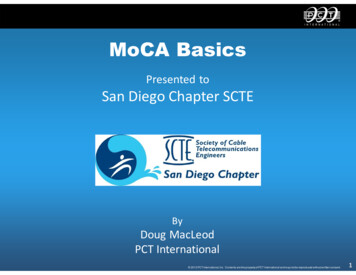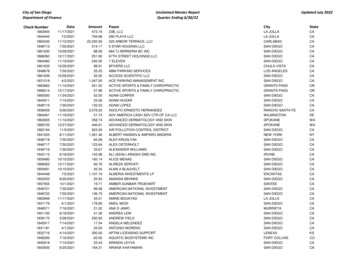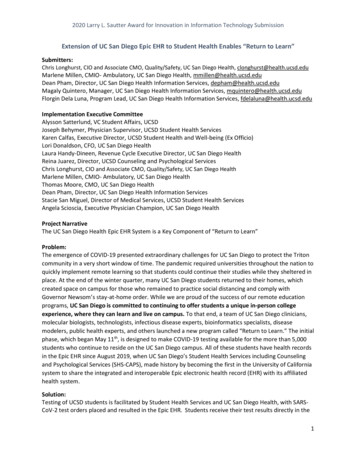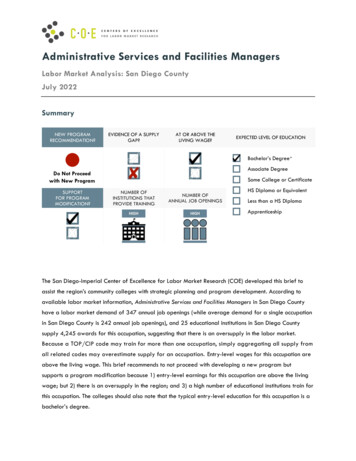
Transcription
MoCA BasicsPresented toSan Diego Chapter SCTEByDoug MacLeodPCT International 2013 PCT International,Inc. Contentsthe propertyof PCT Internationaland maynotbenotreproducedwithoutwrittenconsent.2013 PCT International,Inc. areContentsare the propertyof PCT Internationalandmaybe reproducedwithoutwrittenconsent.1
MoCA Basics – San Diego Chapter SCTEMoCAMultimedia over Coax Alliance What is MoCA?- MoCA is an Ethernetover coaxial cabletechnology that isused to “network”audio/videoelectronics in thehome- MSOs are currentlyimplementingMoCA for multiroom DVRapplications 2013 PCT International, Inc. Contents are the property of PCT International and may not be reproduced without written consent.2
MoCA Basics – San Diego Chapter SCTEMoCAMultimedia over Coax Alliance What is MoCA?- Multimedia over Coax Alliance (MoCA) promotesand specifies delivery of digital entertainment andinformation content over the in-home coaxial cable- Established in 2004- Leverage large installed base of coaxial cable- Large worldwide deployment base of MoCAenabled devices 2013 PCT International, Inc. Contents are the property of PCT International and may not be reproduced without written consent.3
MoCA Basics – San Diego Chapter SCTEMoCAMultimedia over Coax Alliance Applications- Distribution of video in thehouse for applications withmulti-room DVR- High speed networking(sharing of pictures and home videosbetween PCs and media players,backbone network for Wi-Fi extenders)- High definition video streamingfrom the internet- Home security/remote monitoring Alternatives to MoCA- What alternatives exist to MoCA?- Why has the cable industry standardized on MoCA? 2013 PCT International, Inc. Contents are the property of PCT International and may not be reproduced without written consent.4
MoCA Basics – San Diego Chapter SCTEOther In-Home Networking mePlug ax Phy Rate54 600 Mbps1000 Mbps200 Mbps160 Mbps(twisted pair)320 Mbps(coax)270 MbpsBenefitsDrawbacksMobility, no wiresReliability, reduced throughputdue to interference, unlicensedbandHigh speedLack of Cat 5 wiring in homes,dedicated network (media notshared)Power outlets throughout thehouseHigh interference issues, outletuse limited by house wiring,speed and reliability does notmatch MoCAPhone jacks throughout thehouseDoesn't work in a cable modemenvironment, niche market (Telcoonly), no extended standardsdevelopment, performancedoesn't match MoCAReliable, designed to work in a cablemodem environment, fast network,well accepted by service providers(cable, telco, and satellite), continuedstandards developmentAvailability of coax outlets 2013 PCT International, Inc. Contents are the property of PCT International and may not be reproduced without written consent.5
MoCA Basics – San Diego Chapter SCTEWhy MoCA? 90% of homes in North America already have coaxinstalled to at least some of the TV sets in the home The use of coaxial cable ensures a high level ofshielding, providing immunity to interference andnoise (especially when compared to Wi-Fi) MoCA is compatible with cable modem networks as itoccupies bandwidth above the standard HFC frequencyrange MoCA provides the necessary throughput fortransporting multiple data streams carryingmultimedia content 2013 PCT International, Inc. Contents are the property of PCT International and may not be reproduced without written consent.6
MoCA Basics – San Diego Chapter SCTEMoCA 1.1 AttributesRF Frequency Range 2013 PCT International, Inc. Contents are the property of PCT International and may not be reproduced without written consent.7
MoCA Basics – San Diego Chapter SCTEMoCA 1.1 Attributes 8 ea. 50 MHz RF channels, 1125 to 1525 MHz Each channel has- 256 sub-bands, 224 occupied (OFDM) plus guard bands- Each sub-band goes from BPSK to 256 QAM in near real time- Channel 1 (1125-1175) is most likely choice, can be made a requirement viaaddressable set top controls System operation-175 Mbps throughput (target PHY rate of 270 Mbps)Demonstrated operation to 57 dB dynamic rangeTransmitter lowers power when link exceeds target rateBeacon always at maximum output power (56 dBmV) Some MSOs are considering lowering the beacon to 40 dBmV, which also reduces the link budgetto 41 dB, due to concerns with overdriving the input to non-MoCA enabled devices with the highbeacon carrier level- Up to 16 devices on the in-home network TDMA Tx-Rx 2013 PCT International, Inc. Contents are the property of PCT International and may not be reproduced without written consent.8
MoCA Basics – San Diego Chapter SCTEMoCA 2.0 Changes Baseline Mode- 400 Mbps MAC throughput (500 Mbps in turbo mode)- 700 Mbps PHY rate- Single 100 MHz channel Enhanced Mode- 800 Mbps MAC throughput (1 Gbps in turbo mode)- 1.4 Gbps PHY rate- Dual bonded 100 MHz channels (channel bonding) Expanded Operating Frequency Range- 500 through 1650 MHz Additional Changes- Energy saving modes- Reliability improvements (latency, improved PER, re-transmission)- Backward Interoperability 2013 PCT International, Inc. Contents are the property of PCT International and may not be reproduced without written consent.9
MoCA Basics – San Diego Chapter SCTEMoCA Signal Flow 2013 PCT International, Inc. Contents are the property of PCT International and may not be reproduced without written consent.10
MoCA Basics – San Diego Chapter SCTEMoCA Logical Topology Logically, MoCA operatesNode #1Node #2as a fully meshedpoint-to-point network,where each node isinterconnected bi-directionallyto every other node in theMoCA network The data rates for each linkare scalable, up to theaggregate networkNode #4Node #3throughput of 175 Mbps The speed of each link is determined by the quality of thecommunications path between those two nodes 2013 PCT International, Inc. Contents are the property of PCT International and may not be reproduced without written consent.11
MoCA Basics – San Diego Chapter SCTEMoCA Logical Topology Multi-Room DVR Data RateUsage ExampleNode #1Node #2Node #4Node #3- Assuming 1 DVR connected to3 MoCA enabled STBs- Each link is bi-directional andcontains both control informationand the video information Video is MPEG2 HD @ 20 Mbps per stream Control is 1 Mbps Each link is 21 Mbps- Total bandwidth consumed is3 x 21, or 63 Mbps- Data rate remaining for other MoCAservices is 175 Mbps minus 63 Mbps,or 112 Mbps 2013 PCT International, Inc. Contents are the property of PCT International and may not be reproduced without written consent.12
MoCA Basics – San Diego Chapter SCTEDrop Network Considerations Low-pass filter (5 to 1002 MHz) must be installed at eachresidence to protect against adjacent home interference- Ideal location is at the first splitter or in the drop amp to maximize benefit 57 dB maximum loss between MoCA nodes Low splitter insertion loss at MoCA frequencies- Too high splitter insertion loss may limit the number of MoCA devices thatcan be on the same network Low port to port isolation at MoCA frequencies- Port to port isolation is the loss between output ports on a splitter- For operation in the return path (5 to 42 MHz), this needs to be 35 dB- For MoCA frequencies, it should be lower ( 20 dB is targeted, but willwork with current products with higher port to port isolation) 2013 PCT International, Inc. Contents are the property of PCT International and may not be reproduced without written consent.13
MoCA Basics – San Diego Chapter SCTEDrop Network Considerations The MoCA transmitter adjustsits bit rate automatically,depending on channel quality,to maintain a low bit errorrate (BER) at the MoCAreceiver As a result, the PHY rate is ameasure of link quality PHY rate vs. path loss isplotted in the diagram to theright 2013 PCT International, Inc. Contents are the property of PCT International and may not be reproduced without written consent.14
MoCA Basics – San Diego Chapter SCTEMoCA Loss Budget Loss Calculations @ 1125 MHz-Total cable lengthLoss / 100 ft of Series 6 coaxCable lossPort-to-Port isolationof typical 3-way splitter- Total loss @ 1125 MHz50 ft6.95 dB3.48 dB29 dB32.48 dB Loss Calculations @ 1525 MHz-Total cable length50 ftLoss / 100 ft of Series 6 coax 8.09 dBCable loss4.05 dBPort-to-Port isolation22 dBof typical 3-way splitter- Total loss @ 1525 MHz26.05 dB 2013 PCT International, Inc. Contents are the property of PCT International and may not be reproduced without written consent.15
MoCA Basics – San Diego Chapter SCTEMoCA Loss Budget Loss Calculations @ 1125 MHz-Total cable lengthLoss / 100 ft of Series 6 coaxCable lossPort-to-Port isolation oftypical 3-way splitter- Insertion loss of2-way splitter3-way splitter- Total loss @ 1125 MHz100 ft6.95 dB6.95 dB29 dB4.1 dB8.0 dB48.05 dB Loss Calculations @ 1525 MHz-Total cable lengthLoss / 100 ft of Series 6 coaxCable lossPort-to-Port isolation oftypical 3-way splitter- Insertion loss2-way splitter3-way splitter- Total loss @ 1525 MHz100 ft8.09 dB8.09 dB22 dB7.1 dB12.0 dB49.19 dB 2013 PCT International, Inc. Contents are the property of PCT International and may not be reproduced without written consent.16
MoCA Basics – San Diego Chapter SCTEMoCA Filters Are:- Low-pass filters that pass 5 to 1002 MHz and block signals above 1002MHz, and are optimized to block signals within the MoCA frequency rangeused by cable operators, which is 1125 to 1650 MHz- Installed at each residence to protect against adjacent home interferenceand to keep the MoCA signals within the home network Can also:- Help improve performance of the in-home MoCA network Ideal locations:- At the ground block- At the input to the first splitter in the home- In the drop amp to maximize the benefit 2013 PCT International, Inc. Contents are the property of PCT International and may not be reproduced without written consent.17
MoCA Basics – San Diego Chapter SCTEMoCA Filter PerformanceIdeally, a MoCA filter should: Pass 100% of the energy between 5 and 1002 MHz- Insertion loss is a measure of the signal lost passing through a device- If 100% of the signal passes through, the insertion loss would be 0 dB- In practice, close to 1.5 dB of signal is lost passing through a MoCA filterwithin the 5 to 1002 MHz range Reflect 100% of the energy in the MoCA frequency range of1125 to 1650 MHz- Return loss is a measure of the reflected energy, and is the difference, indB, between the forward signal and the reflected signal- If 100% of the signal is reflected, the difference will be 0 dB, so thereturn loss would be 0 dB- In practice, this is usually about 1.5 dB within the 1125 to 1650 MHzrange 2013 PCT International, Inc. Contents are the property of PCT International and may not be reproduced without written consent.18
MoCA Basics – San Diego Chapter SCTEMoCA Filters Used to stop MoCA signals from interfering withadjacent homes- Passes signals below 1002 MHz- Reflects signals above 1002 MHz 2013 PCT International, Inc. Contents are the property of PCT International and may not be reproduced without written consent.19
MoCA Basics – San Diego Chapter SCTEMoCA Filter Benefit Use of the MoCA filter can improve the loss budgetof the MoCA network The reflected energy helps overcome port-to-portisolation of the splitter and lower the lossPort-to-Port Isolation 26 dB Loss @ 1125 MHz-4.1 dB IL-1.5 dB ILMoCA FilterInsertion Loss x 2 Return Loss 4.1 dB 4.1 dB 1.5 dB 9.7 dB total Loss @ 1125 MHz-4.1 dB IL 2013 PCT International, Inc. Contents are the property of PCT International and may not be reproduced without written consent.20
MoCA Basics – San Diego Chapter SCTEMoCA Filters Improve measured port to port isolation due toreflecting signals- Use of a MoCA filter reduces 2-way splitter isolation to 7.5 dB @ 1125 MHz, 10 dB @ 1525 MHz 2013 PCT International, Inc. Contents are the property of PCT International and may not be reproduced without written consent.21
MoCA Basics – San Diego Chapter SCTEMoCA Loss Budget with MoCA Filter Loss Calculations @ 1125 MHz-Total cable length100 ftLoss / 100 ft of Series 6 coax6.95 dBCable loss6.95 dBPort-to-Port isolation of typical12 dB3-way splitter w/MoCA filter installed- Insertion loss2-way splitter4.1 dB3-way splitter8.0 dB- Total loss @ 1125 MHz31.05 dB Loss Calculations @ 1525 MHz-Total cable length100 ftLoss / 100 ft of Series 6 coax8.09 dBCable loss8.09 dBPort-to-Port isolation of typical19 dB3-way splitter w/MoCA filter installed- Insertion loss2-way splitter7.1 dB3-way splitter12.0 dB- Total loss @ 1525 MHz46.19 dB 2013 PCT International, Inc. Contents are the property of PCT International and may not be reproduced without written consent.22
MoCA Basics – San Diego Chapter SCTELoss Budget withMoCA Filter at the Tap Loss calculations @ 1125 MHz tothe MoCA filter at the tap150’-Total cable lengthLoss / 100 ft of Series 6 coaxCable lossInsertion loss3-way splitter2-way splitter- Insertion loss of 3-way splitter- Total loss @ 1125 MHz400 ft6.95 dB27.8 dB8.0 dB4.1 dB8.0 dB47.9 dB Loss calculations @ 1125 MHz bysplitter jumping- Total cable length- Cable loss- Port-to-Port isolation of3-way splitter- Insertion loss2-way splitter3-way splitter- Total loss @ 1125 MHz100 ft6.95 dB29 dB4.1 dB8.0 dB48.05 dB 2013 PCT International, Inc. Contents are the property of PCT International and may not be reproduced without written consent.23
MoCA Basics – San Diego Chapter SCTELoss Budget withMoCA Filter at the Tap Concerns- Loss on the path thru the drop to the filter and back thru the drop hasalmost identical loss as the path that includes the port-to-port isolationthru the splitter (-47.9 dB vs. -48.05 dB)- The propagation delay in the longer path 0.372 µsec- The signals from both paths, virtually identical in strength, will appear atthe MoCA node with a short delay between the two- This may result in potentially degraded performance, including:-Inter-symbol interferenceDegraded MER (modulation error ratio)Packet lossReduced data throughput MoCA is designed to work in an environment that has a greatdeal of reflections, so the extent of the potential interferenceis hard to quantify. The scenario described above is theworst case scenario, and will result in some amount ofdegraded performance. 2013 PCT International, Inc. Contents are the property of PCT International and may not be reproduced without written consent.24
MoCA Basics – San Diego Chapter SCTEDrop Amplifierswith Integrated MoCA Filters LPF ensures MoCA signals (1125 to 1525 MHz) areconstrained to the home network LPF reduces output port to port isolation to minimizeloss for MoCA networking signals 2013 PCT International, Inc. Contents are the property of PCT International and may not be reproduced without written consent.25
MoCA Basics – San Diego Chapter SCTEDrop Amplifiers, 4-Portwith MoCA Filter Output Port to PortIsolation- Typical 30 dB portto port isolationwithout the MoCAfilter- MoCA filterprovides betterthan 10 dBimprovement overstandard dropamps- Ensures link lossbetween devices iswithin 57 dB for aPHY data rate of230 Mbps 2013 PCT International, Inc. Contents are the property of PCT International and may not be reproduced without written consent.26
MoCA Basics – San Diego Chapter SCTEDrop Amplifiers with IntegratedModem Port and MoCA Filter LPF ensures- MoCA signals (1125 to 1525 MHz) are constrained to the home network- Low output port to port isolation to minimize loss for MoCA networking signals MoCA bypass connection enables in-home networking between eMTA, set topboxes, and in-home networking devices (game consoles, PCs, etc.) Passive RF path to eMTA ensures connection to MSO network even in the event ofpower or amplifier failures 2013 PCT International, Inc. Contents are the property of PCT International and may not be reproduced without written consent.27
MoCA Basics – San Diego Chapter SCTEMoCA Drop Amplifierswith 2-Way Splitter Connected Use of an inline MoCA filter or a dropamplifier with integrated MoCA filtercan reduce MoCA link loss by up to15 dB- Splitter connected to MoCA drop amplifier -10 dB port to port isolation- Splitter connected to MoCA filter -10 dB port to port isolation- Splitter connected to typical cable drop -25 dB port to port isolation For best performance, the splitterand MoCA filter should be as closetogether as possible- 1 dB of distance between them willincrease the link loss by 2 dB 2013 PCT International, Inc. Contents are the property of PCT International and may not be reproduced without written consent.28
MoCA Basics – San Diego Chapter SCTETroubleshooting MoCA Standard signal level meters don’t cover MoCA frequenciesabove 1 GHz Drop qualification for MoCA requires a different process thanqualification for other services Node to Node testing for link budget and throughput are bothrequired Based on cable age, loss at MoCA frequencies may be aconcern Drop passives will vary in performance at MoCA frequencies Signal leakage and signal ingress are both concerns in MoCA Drop passive placement in the design is critical to maintainingthe 57 dB MoCA Link BudgetSCTE, through Membership Services, has published an ImplicationPaper written by Spirent titled: “Deploying Enhanced Media Serviceswith MoCA” that includes a detailed section on MoCA testingconsiderations. This document is available for free to SCTE membersat http://www.scte.org/content/index.cfm?pID 1728 2013 PCT International, Inc. Contents are the property of PCT International and may not be reproduced without written consent.29
MoCA Basics – San Diego Chapter SCTEMoCA Recap MoCA can work with existing installation materials Filtering is needed to isolate homes andadd security Filtering can improve the link budget for MoCA Drop amps with MoCA filtering incorporated canimprove MoCA performance Troubleshooting will require new toolsand techniques 2013 PCT International, Inc. Contents are the property of PCT International and may not be reproduced without written consent.30
Questions? 2013 PCT International,Inc. Contentsthe propertyof PCT Internationaland maynotbenotreproducedwithoutwrittenconsent.2013 PCT International,Inc. areContentsare the propertyof PCT Internationalandmaybe reproducedwithoutwrittenconsent.31
MoCA Basics - San Diego Chapter SCTE 2013 PCT International, Inc. Contents are the property of PCT International and may not be reproduced without written consent.











